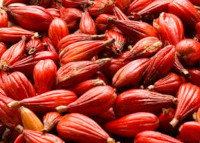HPLC and FT-IR Analyses of Nigerian Alligator Pepper (<i>Aframomum melegueta</i>) Methanol Seed Extract
Main Article Content
Abstract
Traditional knowledge had been established to successfully preserve and restore biodiversity across the continent since it accommodates indigenous herbalism. Traditional medicine had been adopted in Nigeria prior to the colonialism era. The study examined the phytochemical constituents in methanolic seed extract of alligator pepper (Aframomum melegueta) grown in Nigeria by Fourier Transform Infrared Spectrophotometer (FT-IR) and High Performance Liquid Chromatography (HPLC) analyses. Aframomum melegueta seeds were extracted with 70% methanol at room temperature for 48 h. The functional groups in aqueous methanolic seed extract were determined using FT-IR spectroscopic method while the bioactive compounds were determined using HPLC. The FT-IR result established the presence of N-H, C=N, C=C, C-O and O-H functional groups in the methanolic extract. The HPLC analysis of the methanolic extract identified ten compounds. The major components were farnesyl (37.11%), lycopene (34.15%), dihydrocapsiacin (9.55%), capsaicin (8.40%) and delphenidin (7.91%). Other compounds present in the extract at low levels were phytoene (0.74%), β-lonone (0.57%), limonene (0.56%), 6-methoxymellen (0.56%) and trans-beta-ocimene (0.45%). In essence, this study established the ethnobotanical use of Aframomum melegueta as functional food ingredient.
Metrics
Article Details

This work is licensed under a Creative Commons Attribution-NonCommercial 4.0 International License.
References
Hasan I, Hussain S, Millat S, Sen N, Rahman A, Rahman A, Islam S, Moghal MR. Ascertainment of pharmacological activities of Allamanda neriifolia Hook and Aegialitis rotundifolia Roxb used in Bangladesh: An in vitro study. J. Tradit Complement Med.2018;8(1):107-112.
Dissanayake KG., Weerakoon WMTDN, Perera WPRT. Root/stem extracts of Glycyrrhiza glabra as a medicinal plant against disease forming microorganisms. IJSBAR. 2020; 51(1): 1-11.
Khan ME, Adebayo KO, Osigbemhe IG, Maliki M, Bolaji AM, Paul F, Edeeje JP.Comparative proximate composition, anti-nutritional analyses and anti-microbial screening of some Nigerian medicinal plants. FJS. 2023;7(2):159-163.
Sahoo MR, Umashankara MS. FTIR based metabolomics profiling and fingerprinting of some medicinal plants: An attempt to develop an approach for quality control and standardization of herbal materials. Pharmacogn. Res. 2023; 15(1): 163-167.
Shriner RL, Herman CKF, Morril TC, Curti DY, Fuson RC. The Systematic identification of organic compounds. (8th ed.) John Wiley and Sons Inc. 2004.
Pakkirisamy M, Kalakandan SK, Ravichandran K. Phytochemical screening, GC-MS, FTIR analysis of methanolic extract of Curcuma caesia Roxb (BlackTurmeric). Pharmacogn. J. 2017; 9(6): 952-6.
Dolence JM, Poulter CD. Electrophilic alkylations, isomerizations and rearrangements. Comprehensive Natural Products Chemistry. (1st ed.) Pergamon, USA.1999.
Barton D, Nakanishi, K.Comprehensive Natural Products Chemistry. New York: Elsevier Science Inc. 1999. 384-385p.
Engelmann NJ, Clinton SK, Erdman JW. Nutritional aspects of phytoene and phytofluene, carotenoid precursors to lycopene. Adv Nutr. 2011; 2(1): 51-61.
Melendez-Martinez AJ, Vicario IM, Heredia FJ. Carotenoid pigments: Structural and physicochemical considerations. Arch Latinoam Nutr. 2007; 57(2): 109-17.
Alhoshani NM, Al-Zharani M, Almutairi B, Aljarba NH, Al-Johani NS, Alkeraishan N, Alkahtane AA, Alarifi S, Ali D, Alkahtani S. Antioxidant and anti-inflammatory activities of lycopene against 5-fluorouracil-induced cytotoxicity in Caco2 cells. SPJ. 2022; 30(11):1665-1671.
Jeandet P, Hebrard C, Devilled M, Cordelier S, Dorey S, Aziz A, Crouzet J. Deciphering the role of physicochemical in plant-microorganism interactions and human health. Molecules. 2014; 19:18033-18056.
Husain A, Chanana H, Khan S, Dhan Lekshmi UM, Ali M, Alghamdi A, Ahmad A. Chemistry and pharmacological actions of Delphenidin, a dietary purple pigment in anthocyanin and anthocyanin forms. Front. Nutr. 2022; 9:746881.
Paparella A, Shaltiel-Harpaz L, Ibdah M. β-lonone: Its occurrence and biological function and metabolic engineering. Plants. 2021; 10(4): 754.
Aloum L, Alefishat E, Adem A, Petroianu G. Ionone is more than a violet's fragrance. A Review. Molecules. 2020; 25: 5822.
Bomfim LM, Menezes LRA, Rodriguez CBC, Dias RB, Gurgel Rocha CA, Soares MBP, Neto AFS, Nascimento MP, Campos AF, Silva LCR, Costa EV, Bezerra DP. Antitumor activity of the microencapsulation of Annona vepretorum essential oil. Basic Clin Pharmacol and Toxicol. 2016; 118: 208 -213.
Vieira AJ, Beserra FP, Souza MC, Totti BM, Rozza AL. Limonene: Aroma of innovation in health and disease. 2018; 283:97-106.
Haag JD, Lindstrom MJ, Gould MN. (1992). Limonene induced regression of mammary carcinomas. Cancer Res.1992; 52: 4021-4026.
Hachiya S, Kawabata F, Ohnuki K, Inoue N, Yoneda H, Yazawa S, Fushiki T. Effect of CH-19 Sweet, a non pungent cultivar of red pepper on sympathetic nervous activity, body temperature, heart rate and blood pressure in humans. Biosci. Biotechnol. Biochem. 2007; 71: 671-676.
Jeandet P, Delaunois B, Aziz A, Donnez D, Vasserot Y, Cordelier S, Eric C. Metabolic engineering of yeast and plants for the production of the biologically active hydroxystilbene, resveratrol. J. BioMed Biotechnol. 2012; 2012:579089.


